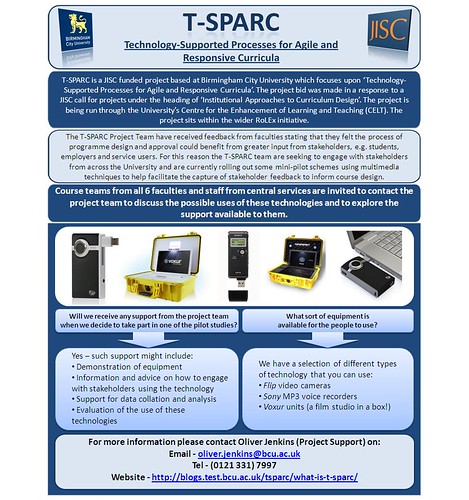On the 14th November Simon Cross, Andrew Brasher and I met with Paul Bartholomew (from Birmingham City’s T-SPARC project) and Martin Jenkins (from CogenT but probably in New Zealand by now where he is due to take up a new post). For our part we were interested in the work T-SPARC have been doing at Birmingham City into looking for learning design solutions to institutional course approval processes, and the work of CogenT in supporting/ enabling learning design dialogues between stakeholders. The discussion was really useful discussion for all of us and has thrown up a number of opportunities for further discussion and collaboration between projects.
Representing the process of design
 Paul began by sharing the progress the T-SPARC project have made in introducing the practice of course teams collecting an e-portfolio of design decisions and outputs throughout the course design process (using the flexible and collaborative Mahara tool). The project focus is on better capturing the process of design rather than the product in the belief that if the process of design is sound, then the product will look after itself. They propose a continual collection process rather than a process interlaced with milestones. Consequently, when data is required (i.e. for a stage in the approval process), the e-portfolio is mined for what evidence is available so far. For the OU we noted this continuous collection could be extended beyond the design in to production (where many design decisions are made).
Paul began by sharing the progress the T-SPARC project have made in introducing the practice of course teams collecting an e-portfolio of design decisions and outputs throughout the course design process (using the flexible and collaborative Mahara tool). The project focus is on better capturing the process of design rather than the product in the belief that if the process of design is sound, then the product will look after itself. They propose a continual collection process rather than a process interlaced with milestones. Consequently, when data is required (i.e. for a stage in the approval process), the e-portfolio is mined for what evidence is available so far. For the OU we noted this continuous collection could be extended beyond the design in to production (where many design decisions are made).
T-SPARC propose that for this part of the design approval process there is no final ’panel’ or committee, rather an Academic Moderator who has a role in reviewing the resources (/evidence) collected by the team and suggesting, or asking them for, additional evidence to demonstrate the design process has been robust. Whether or not all the evidence is later used is immaterial, the very prospect it might be appears to be enough to ensure the course team comply by properly engaging with an explicit design process, and providing opportunities for engaging with, and demonstrating they are responding to, stakeholders (including students and employers). In the case of the OU we noted this could be extended to ALs, other support units and support staff in the regions.
The benefit of gathering evidence is presented as having primary benefit to the course team members themselves – to develop better understanding of the design and to ensure a good design is produced. It has also been found to empowering for individuals who feel that if a meeting etc is being captured and reviewed, then they have a voice and their point may be more likely to register. The members of staff involved here are also usually involved in the teaching of the course so have additional incentive to work fully through the design.
Paul felt that many of the activities and curriculum representations developed as part of the OULDI project may well help teams to have productive and collaborative design discussions about the courses they are developing – the outputs of these activities could then be presented as evidence.
Supporting design dialogues with a variety of stakeholders
Martin demonstrated the online website of the CogenT project which has been developed in conjunction with PebblePad over the last 18 months. The toolkit aims to support the co-creation (co-generation) of curricula by academics and employers. The process is structured by a series of forms: the vocabulary builder allows designers to select words and clarify the level of competency/achievement they associate with it (i.e. analyse at level 3, or 4, or 5). These levels are informed by, and provide the designer with the wording of, formal descriptors. The second part is an outcome builder that moves on from the descriptors to requiring an outcome to be defined. The third component, a task builder, leads on to the final design builder (which pulls individual activity, support and outcomes together with some meta-data and displays these for other designers to find).
At present the tools is being used with specific teams but there is potential for developing a workshop style activity around the use of the tool. Andrew was interested in the potential of how the vocabulary-level-descriptor information could be used by other applications (such as CompendiumLD). We also acknowledged that this would be of great interest to support units for making their design visible and providing a place where course team could demonstrate they’d visited as part of the design evidence capture process.
[…] been reflecting on a range of our recent meetings and project related activities (including meeting with colleageus from Birmingham City and Gloucestershire, with our external partners, and […]